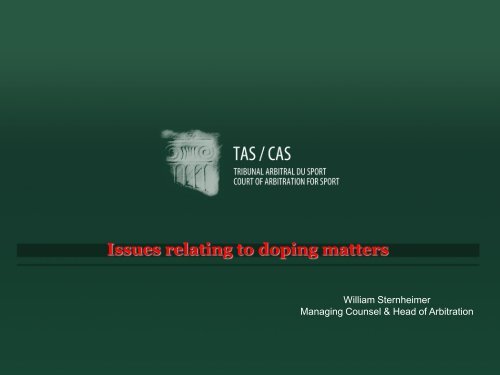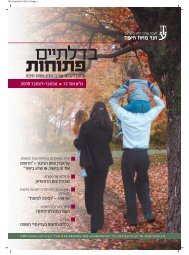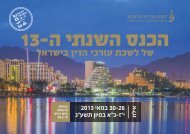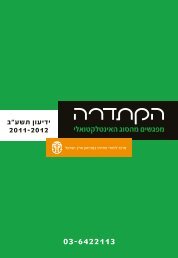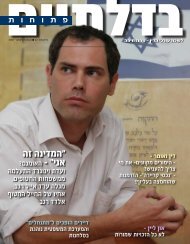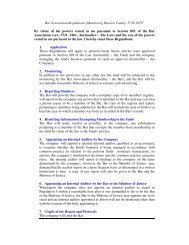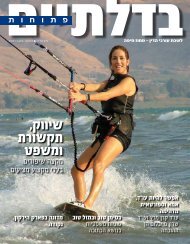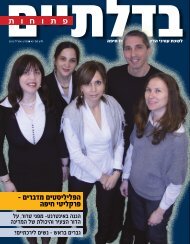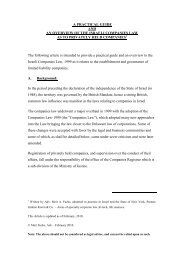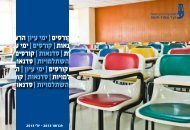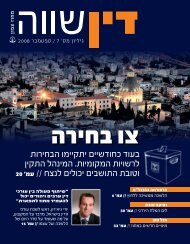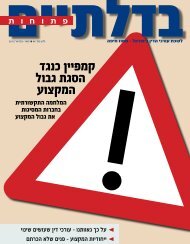III. Sanctions on individuals
III. Sanctions on individuals
III. Sanctions on individuals
Create successful ePaper yourself
Turn your PDF publications into a flip-book with our unique Google optimized e-Paper software.
Issues relating to doping matters<br />
William Sternheimer<br />
Managing Counsel & Head of Arbitrati<strong>on</strong>
Table of c<strong>on</strong>tents<br />
I. Introducti<strong>on</strong><br />
II. Proof of doping<br />
<str<strong>on</strong>g>III</str<strong>on</strong>g>. <str<strong>on</strong>g>Sancti<strong>on</strong>s</str<strong>on</strong>g> <strong>on</strong> <strong>individuals</strong><br />
IV. C<strong>on</strong>sequences to teams<br />
V. C<strong>on</strong>clusi<strong>on</strong>
I. Introducti<strong>on</strong><br />
• In 2003, the World Anti-Doping Code was adopted<br />
• The WADA Code was amended in 2009<br />
• A new revisi<strong>on</strong> of the WADA Code is scheduled for 2015<br />
• Under Article 13.2.1 of the WADA Code, in cases arising from participati<strong>on</strong> in an<br />
internati<strong>on</strong>al event or in cases involving internati<strong>on</strong>al-level athletes, the decisi<strong>on</strong> may<br />
be appealed exclusively to CAS in accordance with the provisi<strong>on</strong>s applicable before<br />
such court<br />
• Approximately 35% of the cases before the CAS are related to doping<br />
• The present presentati<strong>on</strong> will focus <strong>on</strong> the main issues which may arise before the<br />
CAS in relati<strong>on</strong> to doping matters<br />
• It is each athlete’s pers<strong>on</strong>al duty to ensure that no prohibited substance enters her/his<br />
body. Athletes are resp<strong>on</strong>sible for any prohibited substance or its metabolites or<br />
markers found to be present in their samples. Accordingly, it is not necessary that<br />
intent, fault, negligence or knowing use <strong>on</strong> the athlete’s part be dem<strong>on</strong>strated in order<br />
to establish an anti-doping rule violati<strong>on</strong> (Article 2.1.1)
I. Introducti<strong>on</strong><br />
• The delegati<strong>on</strong> of the athletes’ anti-doping duties does not excuse the athletes from<br />
their resp<strong>on</strong>sibility. It would indeed be to the severe detriment of the fight against<br />
doping if athletes were in a positi<strong>on</strong> to assign their obligati<strong>on</strong>s to third pers<strong>on</strong>s and<br />
c<strong>on</strong>sequently to avoid any liability for the presence of a prohibited substance in their<br />
sample (CAS OG 04/003 Torri Edwards v. IAAF, CAS 2006/A/1032 Sesil<br />
Karatancheva v. ITF, CAS 2012/A/2763 IAAF v. AFI & Akkunji Ashwini, Priyanka<br />
Panwar, Tiana Mary Thomas & Sini Jose)<br />
• All the anti-doping rule violati<strong>on</strong>s c<strong>on</strong>cerning athletes are provided under:<br />
‣ Article 2.2 - use or attempted use by an athlete of a prohibited substance or method<br />
‣ Article 2.3 – refusing or failing without compelling justificati<strong>on</strong> to submit to sample<br />
collecti<strong>on</strong>, or evading sample collecti<strong>on</strong><br />
‣ Article 2.4 – violati<strong>on</strong> of applicable requirements regarding athlete availability for outof-competiti<strong>on</strong><br />
testing, including failure to file required whereabouts informati<strong>on</strong> and<br />
missed tests (three within 18 m<strong>on</strong>ths)
I. Introducti<strong>on</strong><br />
‣ Article 2.5 – tampering or attempted tampering with any part of doping c<strong>on</strong>trol<br />
‣ Article 2.6 – possessi<strong>on</strong> of prohibited substances and methods<br />
‣ Article 2.7 – trafficking or attempted trafficking of any prohibited substance or<br />
method<br />
‣ Article 2.8 – administrati<strong>on</strong> or attempted administrati<strong>on</strong> to any athlete incompetiti<strong>on</strong><br />
or out-of-competiti<strong>on</strong> of any prohibited substance or method, or<br />
assisting, encouraging, aiding, abetting, covering up or any other type of<br />
complicity involving an anti-doping rule violati<strong>on</strong> or any attempted violati<strong>on</strong>
II. Proof of doping<br />
• The anti-doping organizati<strong>on</strong> shall have the burden of establishing that an anti-doping<br />
rule violati<strong>on</strong> has occurred. The standard of proof shall be whether the ADO has<br />
established an anti-doping rule violati<strong>on</strong> to the comfortable satisfacti<strong>on</strong> of the hearing<br />
panel bearing in mind the seriousness of the allegati<strong>on</strong> which is made. This standard<br />
of proof is greater than a mere balance of probability but less than proof bey<strong>on</strong>d a<br />
reas<strong>on</strong>able doubt (Article 3.1)<br />
• Where the WADA Code places the burden of proof <strong>on</strong> the athlete alleged to have<br />
committed an anti-doping rule violati<strong>on</strong> to rebut a presumpti<strong>on</strong>, the standard of proof<br />
shall be by a balance of probability, except if provided otherwise (Article 3.1)<br />
• Facts related to anti-doping rule violati<strong>on</strong>s may be established by any reliable means,<br />
including admissi<strong>on</strong>s (Article 3.2)<br />
‣ Testim<strong>on</strong>ies (CAS 2004/O/645 USADA v. Tim M<strong>on</strong>tgomery, CAS 2004/O/649<br />
USADA v. Chryste Gaines)<br />
‣ Athlete’s biological passport (CAS 2010/A/2174 Francesco De B<strong>on</strong>is v. CONI &<br />
UCI, CAS 2010/A/2235 UCI v. Tadej Valjavec & OCS)<br />
‣ DNA analysis (TAS 2009/A/1879 Alejandro Valverde c. CONI)
II. Proof of doping<br />
• WADA-accredited laboratories are presumed to have c<strong>on</strong>ducted sample analysis and<br />
custodial procedures in accordance with the internati<strong>on</strong>al standard for laboratories.<br />
The athlete may rebut this presumpti<strong>on</strong> by establishing that a departure from such<br />
standard occurred which could reas<strong>on</strong>ably have caused the AAF. If the athlete rebuts<br />
this presumpti<strong>on</strong>, then the ADO shall have the burden to establish that such departure<br />
did not cause the AAF (Article 3.2.1)<br />
‣ Some athletes have failed to rebut this presumpti<strong>on</strong>: CAS 2005/A/884 Tyler<br />
Hamilt<strong>on</strong> v. USDA & UCI, CAS 2007/A/1394 Floyd Landis v. USADA, TAS<br />
2007/A/1444 & 2008/A/1465 UCI c. Iban Mayo & RFEC<br />
‣ Others succeeded: TAS 2006/A/1119 UCI c. Iñigo Landaluce, CAS 2008/A/1607<br />
Varis v. IBU, CAS 2009/A/1752 & 1753 Devyatovskiy & Tsikhan v. IOC, CAS<br />
2010/A/2161 Wen T<strong>on</strong>g v. IJF<br />
• The same applies to other standards (Article 3.2.2)<br />
• The hearing panel may draw an inference adverse to the athlete who is asserted to<br />
have committed an anti-doping rule violati<strong>on</strong> based <strong>on</strong> her/his refusal to appear at the<br />
hearing and to answer questi<strong>on</strong>s from the hearing panel (Article 3.2.4)
<str<strong>on</strong>g>III</str<strong>on</strong>g>. <str<strong>on</strong>g>Sancti<strong>on</strong>s</str<strong>on</strong>g> <strong>on</strong> <strong>individuals</strong><br />
• The period of ineligibility imposed for a first violati<strong>on</strong> of Articles 2.1, 2.2 or 2.6 shall be<br />
2 years, unless the c<strong>on</strong>diti<strong>on</strong>s for eliminating or reducing the period of ineligibility or<br />
the <strong>on</strong>es for increasing it, are met (Article 10.2)<br />
• For violati<strong>on</strong>s of Articles 2.3 or 2.5, the period of ineligibility imposed shall be 2 years<br />
unless the c<strong>on</strong>diti<strong>on</strong>s for eliminating the period of ineligibility or the <strong>on</strong>es for<br />
increasing it, are met (Article 10.3.1)<br />
• For violati<strong>on</strong>s of Articles 2.7 or 2.8, the period of ineligibility imposed shall be a<br />
minimum of 4 years up to lifetime unless the c<strong>on</strong>diti<strong>on</strong>s for eliminating the period of<br />
ineligibility are met (Article 10.3.2)<br />
• For violati<strong>on</strong>s of Article 2.4, the period of ineligibility imposed shall be at a minimum 1<br />
year and at a maximum 2 years based <strong>on</strong> the athlete’s degree of fault (Article 10.3.3)
<str<strong>on</strong>g>III</str<strong>on</strong>g>. <str<strong>on</strong>g>Sancti<strong>on</strong>s</str<strong>on</strong>g> <strong>on</strong> <strong>individuals</strong><br />
• Article 10.4 – Eliminati<strong>on</strong> or reducti<strong>on</strong> of the period of ineligibility for specified<br />
substances under specific circumstances<br />
Where an athlete can establish how a specified substance entered her/his body<br />
or came into her/his possessi<strong>on</strong> and that such specified substance was not<br />
intended to enhance the athlete’s sport performance, the period of ineligibility of<br />
Article 10.2 shall be replaced by, at a minimum, a reprimand and, at a maximum,<br />
2 years of ineligibility<br />
To justify any eliminati<strong>on</strong> or reducti<strong>on</strong>, the athlete must produce corroborating<br />
evidence which establishes to the comfortable satisfacti<strong>on</strong> of the hearing panel<br />
the absence of an intent to enhance sport performance or mask the use of a<br />
performance-enhancing substance. The athlete’s degree of fault shall be the<br />
criteri<strong>on</strong> c<strong>on</strong>sidered in assessing any reducti<strong>on</strong> of the period of ineligibility<br />
• Examples of cases where Article 10.4 has been applied and where the intent to<br />
enhance sport performance was not an issue (the sports-body agreed to the absence<br />
of intent to enhance performance): CAS 2011/A/2495 FINA v. Cielo & CBDA, CAS<br />
2011/A/2518 Robert Kendrick v. ITF
<str<strong>on</strong>g>III</str<strong>on</strong>g>. <str<strong>on</strong>g>Sancti<strong>on</strong>s</str<strong>on</strong>g> <strong>on</strong> <strong>individuals</strong><br />
• On the intent to enhance sport performance, there are some c<strong>on</strong>tradictory CAS<br />
awards:<br />
‣ CAS 2010/A/2107 Flavia Oliveira v. USADA: the athlete did not know she was<br />
taking a prohibited substance as it was labelled <strong>on</strong> the product differently than <strong>on</strong><br />
the WADA list of prohibited substances. Only the use of the substance should be<br />
taken into c<strong>on</strong>siderati<strong>on</strong> when assessing the intent (CAS 2011/A/2645 UCI v.<br />
Alexander Kolobnev & RCF)<br />
‣ CAS A2/2011 Kurt Foggo v. Nati<strong>on</strong>al Rugby League: the use of the product shall<br />
be taken into c<strong>on</strong>siderati<strong>on</strong> when assessing the intent, not <strong>on</strong>ly the substance<br />
‣ CAS 2012/A/2804 Dimitar Kutrovsky v. ITF: an athlete’s knowledge or lack of<br />
knowledge that he has ingested a specified substance is relevant to the issue of<br />
intent but cannot of itself decide it. Foggo approach must be followed<br />
• When the Panel does not have to address the issue of intent, it automatically looks at<br />
the product itself and not the substance (CAS 2011/A/2495 FINA v. Cielo & CBDA)<br />
• The first draft of the WADA Code for 2015 clearly states that the Oliveira approach<br />
should not be favored. WADA now seems to go towards a deleti<strong>on</strong> of the intent
<str<strong>on</strong>g>III</str<strong>on</strong>g>. <str<strong>on</strong>g>Sancti<strong>on</strong>s</str<strong>on</strong>g> <strong>on</strong> <strong>individuals</strong><br />
• Article 10.5 – Eliminati<strong>on</strong> or reducti<strong>on</strong> of period of ineligibility based <strong>on</strong> excepti<strong>on</strong>al<br />
circumstances<br />
‣ Article 10.5.1 No fault or negligence<br />
If the athlete establishes that she/he bears no fault or negligence, the<br />
otherwise applicable period of ineligibility shall be eliminated. The athlete<br />
must also establish how the prohibited substance entered her/his system (for<br />
Article 2.1 cases). If this article is applied, the anti-doping rule violati<strong>on</strong> shall<br />
not be c<strong>on</strong>sidered a violati<strong>on</strong> for the purpose of determining the period of<br />
ineligibility for multiple violati<strong>on</strong>s under Article 10.7<br />
‣ Cases where CAS held that the athlete proved how the substance entered<br />
her/his system and established the she/he bears no fault or negligence: CAS<br />
2005/A/990 Oleksandr Pobyed<strong>on</strong>ostsev v. IIHF, CAS 2009/A/1926 & 1930 ITF &<br />
WADA v. Richard Gasquet
<str<strong>on</strong>g>III</str<strong>on</strong>g>. <str<strong>on</strong>g>Sancti<strong>on</strong>s</str<strong>on</strong>g> <strong>on</strong> <strong>individuals</strong><br />
‣ Article 10.5.2 No significant fault or negligence<br />
If an athlete establishes that she/he bears no significant fault or negligence,<br />
the otherwise applicable period of ineligibility may be reduced but such<br />
reducti<strong>on</strong> may not be less that <strong>on</strong>e-half of the period of ineligibility otherwise<br />
applicable. If the otherwise applicable period of ineligibility is a lifetime, the<br />
reduced period may not be less than eight years. The athlete must also<br />
establish how the prohibited substance entered her/his system (for Article<br />
2.1 cases)<br />
‣ Cases where CAS held that the athlete proved how the substance entered<br />
her/his system and established the she/he bears no significant fault or<br />
negligence: CAS 2005/A/951 Guillermo Cañas v. ATP, CAS 2006/A/1025 Mariano<br />
Puerta v. ITF<br />
‣ Cases where CAS held that the athlete proved how the substance entered<br />
her/his system (but not the absence of fault or significant fault): CAS<br />
2006/A/1067 IRB v. Jas<strong>on</strong> Keyter, CAS 2006/A/1130 WADA v. Darko Stanic &<br />
Swiss Olympic, TAS 2006/A/1038 Joseph N’Sima c. FIBA & AMA
<str<strong>on</strong>g>III</str<strong>on</strong>g>. <str<strong>on</strong>g>Sancti<strong>on</strong>s</str<strong>on</strong>g> <strong>on</strong> <strong>individuals</strong><br />
• Article 10.7 – Multiple violati<strong>on</strong>s<br />
1st<br />
2nd<br />
Reduced<br />
sancti<strong>on</strong><br />
Reduced<br />
sancti<strong>on</strong><br />
Filing failures<br />
/ Missed tests<br />
No significant<br />
fault<br />
Standard<br />
sancti<strong>on</strong><br />
Aggravated<br />
sancti<strong>on</strong><br />
Trafficking /<br />
Administratio<br />
n<br />
1-4 2-4 2-4 4-6 8-10 10-life<br />
Filing failures<br />
/ Missed tests<br />
1-4 4-8 4-8 6-8 10-life life<br />
No significant<br />
fault<br />
1-4 4-8 4-8 6-8 10-life life<br />
Standard<br />
sancti<strong>on</strong><br />
Aggravated<br />
sancti<strong>on</strong><br />
Trafficking /<br />
Administratio<br />
n<br />
2-4 6-8 6-8 8-life life life<br />
4-5 10-life 10-life life life life<br />
8-life life life life life life
<str<strong>on</strong>g>III</str<strong>on</strong>g>. <str<strong>on</strong>g>Sancti<strong>on</strong>s</str<strong>on</strong>g> <strong>on</strong> <strong>individuals</strong><br />
• In additi<strong>on</strong> to the automatic disqualificati<strong>on</strong> of the results in the competiti<strong>on</strong> which<br />
produced the positive sample (Article 9), all other competitive results obtained from<br />
the date a positive sample was collected, or other anti-doping rule violati<strong>on</strong> occurred,<br />
through the commencement of any provisi<strong>on</strong>al suspensi<strong>on</strong> or ineligibility period, shall,<br />
unless fairness requires otherwise, be disqualified will all of the resulting<br />
c<strong>on</strong>sequences including forfeiture of any medals, points and prizes (Article 10.8)<br />
• As a c<strong>on</strong>diti<strong>on</strong> of regaining eligibility after being found to have committed an antidoping<br />
rule violati<strong>on</strong>, the athlete must first repay all price m<strong>on</strong>ey forfeited (Article<br />
10.8.1)<br />
• The period of ineligibility shall start <strong>on</strong> the date of the hearing decisi<strong>on</strong> providing for<br />
ineligibility or, if the hearing is waived, <strong>on</strong> the date the ineligibility is accepted or<br />
otherwise imposed. Any period of provisi<strong>on</strong>al suspensi<strong>on</strong> shall be credited against the<br />
period of ineligibility imposed (Article 10.9)<br />
• Where there have been substantial delays in the hearing process or other aspects of<br />
doping c<strong>on</strong>trol not attributable to the athlete, the period of ineligibility may start at an<br />
earlier date commencing as early as the date of sample collecti<strong>on</strong> or the date <strong>on</strong><br />
which another anti-doping rule violati<strong>on</strong> last occurred (Article 10.9.1)
IV. C<strong>on</strong>sequences to teams<br />
• If more than two members of a team in a team sport are found to have committed an<br />
anti-doping rule violati<strong>on</strong> during an event period, the ruling body of the event shall<br />
impose an appropriate sancti<strong>on</strong> <strong>on</strong> the team (e.g. loss of points, disqualificati<strong>on</strong> from<br />
a competiti<strong>on</strong> or event, or other sancti<strong>on</strong>) in additi<strong>on</strong> to any c<strong>on</strong>sequences imposed<br />
up<strong>on</strong> the individual athletes committing the anti-doping rule violati<strong>on</strong> (Article 11.2)<br />
• The ruling body for an event may elect to establish rules for the event which imposes<br />
c<strong>on</strong>sequences for team sports stricter than those in Article 11.2 for purposed of the<br />
event<br />
‣ CAS 2008/A/1545 Andrea Anders<strong>on</strong>, LaTasha Colander Clark, Jearl Miles-Clark,<br />
Torri Edwards, Chryste Gaines, M<strong>on</strong>ique Hennegan, Passi<strong>on</strong> Richards<strong>on</strong> v. IOC:<br />
results of the US female relays during the 2000 Olympic Games. IAAF rule<br />
according to which if an athlete is tested positive in a relay competiti<strong>on</strong>, the team<br />
results are annulled did not exist before 2004
V. C<strong>on</strong>clusi<strong>on</strong><br />
• I remain at your disposal to answer any and all questi<strong>on</strong>s you may have<br />
THANK YOU VERY MUCH
Tribunal Arbitral du Sport<br />
Court of Arbitrati<strong>on</strong> for Sport<br />
Château de Béthusy<br />
Av. de Beaum<strong>on</strong>t 2<br />
CH-1012 Lausanne<br />
Suisse<br />
Tel: +41 21 613 50 00<br />
Fax: +41 21 613 50 01<br />
info@tas-cas.org<br />
www.tas-cas.org


